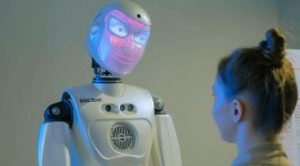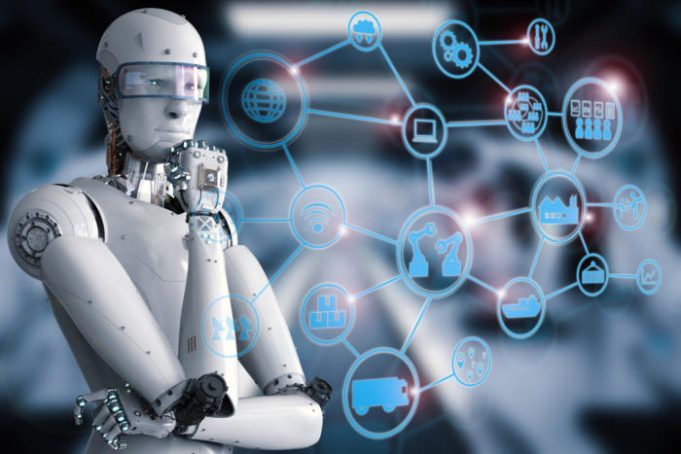Back in the 1950s, the fathers of the field, Minsky and McCarthy, described artificial intelligence as any task performed by a machine that would have previously been considered to require human intelligence.
“Artificial intelligence is the simulation of human intelligence processes by machines, especially computer systems.”
Modern definitions of what it means to create intelligence are more specific. Francois Chollet, an AI researcher at Google and creator of the machine-learning software library Keras, has said intelligence is tied to a system’s ability to adapt and improvise in a new environment, to generalise its knowledge and apply it to unfamiliar scenarios.
“Intelligence is the efficiency with which you acquire new skills at tasks you didn’t previously prepare for,” he said.
“Intelligence is not skill itself; it’s not what you can do; it’s how well and how efficiently you can learn new things.”


What are the uses for AI?
AI is ubiquitous today, used to recommend what you should buy next online, to understand what you say to virtual assistants, such as Amazon’s Alexa and Apple’s Siri, to recognise who and what is in a photo, spot spam, or spot spam detect credit card fraud.
What are the different types of AI?
Narrow AI
Narrow AI is what we see all around us in computers today — intelligent systems that have been taught or have learned how to carry out specific tasks without being explicitly programmed how to do so.
This type of machine intelligence is evident in the speech and language recognition of the Siri virtual assistant on the Apple iPhone, in the vision-recognition systems on self-driving cars, or in the recommendation engines that suggest products you might like based on what you bought in the past. Unlike humans, these systems can only learn or be taught how to do defined tasks, which is why they are called narrow AI.
General AI
General AI is very different and is the type of adaptable intellect found in humans, a flexible form of intelligence capable of learning how to carry out vastly different tasks, anything from haircutting to building spreadsheets or reasoning about a wide variety of topics based on its accumulated experience.
This is the sort of AI more commonly seen in movies, the likes of HAL in 2001 or Skynet in The Terminator, but which doesn’t exist today – and AI experts are fiercely divided over how soon it will become a reality.
“”
What are recent landmarks in the development of AI?


While modern narrow AI may be limited to performing specific tasks, within their specialisms, these systems are sometimes capable of superhuman performance, in some instances even demonstrating superior creativity, a trait often held up as intrinsically human.
There have been too many breakthroughs to put together a definitive list, but some highlights include:
- In 2009 Google showed its self-driving Toyota Prius could complete more than 10 journeys of 100 miles each, setting society on a path towards driverless vehicles.
- In 2011, the computer system IBM Watson made headlines worldwide when it won the US quiz show Jeopardy!, beating two of the best players the show had ever produced. To win the show, Watson used natural language processing and analytics on vast repositories of data that is processed to answer human-posed questions, often in a fraction of a second.
- In 2012, another breakthrough heralded AI’s potential to tackle a multitude of new tasks previously thought of as too complex for any machine. That year, the AlexNet system decisively triumphed in the ImageNet Large Scale Visual Recognition Challenge. AlexNet’s accuracy was such that it halved the error rate compared to rival systems in the image-recognition contest.
Which AI services are available?
All of the major cloud platforms — Amazon Web Services, Microsoft Azure and Google Cloud Platform — provide access to GPU arrays for training and running machine-learning models, with Google also gearing up to let users use its Tensor Processing Units — custom chips whose design is optimized for training and running machine-learning models.
All of the necessary associated infrastructure and services are available from the big three, the cloud-based data stores, capable of holding the vast amount of data needed to train machine-learning models, services to transform data to prepare it for analysis, visualisation tools to display the results clearly, and software that simplifies the building of models.
These cloud platforms are even simplifying the creation of custom machine-learning models, with Google offering a service that automates the creation of AI models, called Cloud AutoML. This drag-and-drop service builds custom image-recognition models and requires the user to have no machine-learning expertise.
Cloud-based, machine-learning services are constantly evolving. Amazon now offers a host of AWS offerings designed to streamline the process of training up machine-learning models and recently launched Amazon SageMaker Clarify, a tool to help organizations root out biases and imbalances in training data that could lead to skewed predictions by the trained model.
For those firms that don’t want to build their own machine=learning models but instead want to consume AI-powered, on-demand services, such as voice, vision, and language recognition, Microsoft Azure stands out for the breadth of services on offer, closely followed by Google Cloud Platform and then AWS. Meanwhile, IBM, alongside its more general on-demand offerings, is also attempting to sell sector-specific AI services aimed at everything from healthcare to retail, grouping these offerings together under its IBM Watson umbrella, and having invested $2bn in buying The Weather Channel to unlock a trove of data to augment its AI services.









